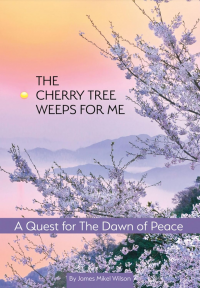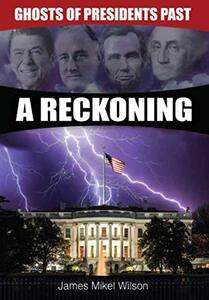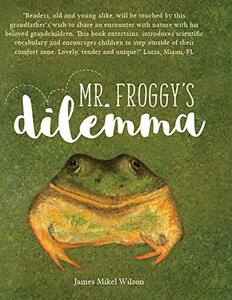James Mikel Wilson Interview Published on: 15, Apr 2025
 Growing up in the lingering shadows of WWII, how did your family's experiences influence your perspective on history and war?
Growing up in the lingering shadows of WWII, how did your family's experiences influence your perspective on history and war?
Harmlessly, I experienced the percussions of war weekly. My childhood home perched on a bluff above the Mississippi River and Valley, overlooking the Rock Island Arsenal in the middle of the river. Even through my college years, the arsenal would test their products (anti-tank guns, rocket launchers, and howitzers), and the deep-throated booms would resonate and echo across the river and the bluffs on both sides and rattle walls and windows. It was a frequent reminder of wars our country had fought and might again someday. The Arsenal's Museum is the second oldest in the country and satiates those curious about America's long history of conflict. Family members fought in every major war, beginning with the Revolutionary War. My turn came with Vietnam. Many in my generation questioned why that war happened and how it might have been avoided—the same with the Korean War.
Having traveled to five continents and 33 countries, what moments or insights most shaped your understanding of the world?We are connected and interdependent more than we realize (e.g., COVID-19, commerce, and the environment). People from every country and culture crave some form of Maslow's Hierarchy of Needs (basic food and shelter, safety and health, love and belonging, esteem, and self-actualization) without necessarily knowing the concept. However, the type of government influences the extent to which these needs are satisfied. As Takashi Komatsu stated in his Harvard Commencement speech, the Dawn of Peace, "Man's humanity to man is the path to peace and prosperity." Today, it is generally a universally recognized concept, but countries, including mine, vary in their practice over time. Another perception I acquired while living and traveling abroad is that Americans are often unique in their willingness to perform volunteer work.
What initially sparked your deep interest in WWII history and the political landscape that led to the war?My first name comes from my Uncle, a Navy Captain who graduated from the U.S. Naval Academy, James Baird, who fought in the Pacific War. His ship, the USS Helena, was almost sunk during the attack on Pearl Harbor and later went down fighting in the battle of the Kula Gulf. He was a lifelong student of history and a serious stamp collector. He took me under his wing, and I admired him. And although I majored in economics and then acquired an MBA, my history professor at Monmouth College, Mary Crow, brought history to life. She was less interested in facts and dates than what history spoke to us. She sparked my curiosity beyond who won wars to why they happened and speculation whether they could have been prevented.
Your book Churchill and Roosevelt: The Big Sleepover at the White House earned an Author Academy Award. What was the most surprising or lesser-known fact you uncovered while researching it?The most surprising was that President Roosevelt tried to dissuade Churchill from visiting so soon after the attack on Pearl Harbor. He and the nation were overwhelmed by abrupt entry into war and ill-prepared. The government needed to focus all its energies on responding to the chaos. Hosting a foreign head of state was the last thing on its mind. Fortunately, Churchill prevailed! Perhaps lesser known to some is how pivotal those three weeks together were in setting a path to victory. This obscure but vital turning point would fuse allies into concerted action and lead to the formation of the United Nations. Another revelation: The critical role India played in liberating Italy from Nazi control and checking the advance of the Japanese army in Asia.
How did the adaptation of your book into the stage play Alliance come about, and what was it like seeing your work performed?Soley, due to providence! My illustrator, Tod Gilpin, discovered a life-sized sculpture of Churchill and Roosevelt sitting on a bench and lamented that it was too bad we couldn't get permission to use a picture on the front cover. So, I cold called the sculptor, Lawrence Holofcener, and his wife, Julia, who readily granted permission. To make a long story short, the couple, for decades, had been a significant force in the arts, including writing and producing stage plays. After seeing the completed book, they requested permission to create a stage play from the work. It was an honor to watch four characters read the play for the first time at the annual International Churchill Conference in London, attended by over 3,000 in person or by Zoom.
What drew you to the story of Takashi Komatsu, and why do you think his journey is essential for understanding Japan’s transformation?Curiosity! I wanted to learn what possessed a 12-year-old Komatsu to travel from Tokyo to New York City in 1899 without family or financial backing. It seemed incredible and unimaginable. Then, when I learned of his prodigious accomplishments later in life, I knew I wanted to know more. So, I began two years of research and interviews to understand Japan's Meiji era, how bad actors uprooted a democracy, and how Japan recovered its democracy. Komatsu's journey illustrates that former enemies can begin to build trust and eventually forge a friendship. He played a unique and forgotten role in making that happen, including his relationships with U.S. citizens before and after the war. Chance played a part as well. What were the odds that Komatsu would encounter in Japan, just a few days after the war's end, Donovan Vance, the little American boy who lived next door to him 35 years earlier in Monmouth, Illinois? He is now a Colonel responsible for half of Japan's occupation and reports directly to General Douglas MacArthur.
Writing historical nonfiction requires deep research. How do you ensure accuracy and authenticity in your books?History is what historians tell us, and they are not infallible. The best authors scrutinize sources, attempt to cross-collaborate their truthfulness and accuracy, and look to see if alternative views exist. We have to take care not to infuse our beliefs and predispositions without qualification. For example, I wanted to believe that Komatsu didn't know what was happening in Manchuria. At first, he probably didn't. I employ narrative nonfiction and try to identify situations where some dialogue is not provable but plausible, given the surrounding people, events, and facts. Some died-in-the-wool nonfiction writers would not ascribe to this approach. Nonetheless, we need to make history more engaging because of the lessons that can be learned from it. Narrative nonfiction, an emerging genre, helps accomplish this goal.
Your book, The Cherry Tree Weeps for Me, focuses on Komatsu’s quest for peace. What lessons from his story resonate most with today’s global conflicts?It speaks to conflicts in the Ukraine, the Middle East, and elsewhere. Wars often end because one side wins, both sides have exhausted themselves, or enlightenment leads to peace. The book raises the question of whether the war between Japan and the U.S. could have been prevented. For example, the U.S. State Department failed to listen to its U.S. Ambassador in Japan, Joseph Grew, regarding opportunities and overtures to avoid/forestall war. Also important is how a familiar track can lead to war. Like Japan in the 1920s and 30s, it began with festering issues, followed by lies, deceptions, jingoism, manipulation of the press, threats, tariffs, embargoes, and playing to constituents' worst fears and/or extreme beliefs. Komatsu's biography provided an essential vehicle for telling this story.
How do you balance factual storytelling with engaging narrative elements to captivate readers?A willingness to do extensive and patient research helps. Interesting nuggets exist if one can find them like something surprising or not previously well-known. It also helps if the researcher can interconnect seemingly unrelated information, which adds an element of surprise. I am a better researcher than a writer and enjoy the process more. Angels of information exist who can help enrich content. I mention five of them in the acknowledgments section of The Cherry Tree Weeps for Me. It also helps to write about forgotten people and events that speak to the present. And as mentioned, I employ narrative or creative nonfiction tools that are becoming more acceptable. That means occasionally giving a voice to a historical character that may not be provable but highly plausible, given the circumstances and surrounding facts.
You’ve also written books on politics, pets, and children’s literature. How do you shift between such different genres?I write about what interests, informs, and amuses me. My remaining lifespan is too short to worry about genres. If you look closely at all those works, threads of American history weave through all of them. It is a gamble to see if someone else may appreciate my endeavors. And I don't write for a livelihood, Ha, I'd starve if I did! But I do write for causes.
Your book Paw Tracks Here and Abroad: A Dog's Tale was promoted by the ASPCA. How did that partnership come about?We shared life with two adopted dogs who, between them, lived 35 years with our family. They were the best! We believe in and support pet adoption. Answering your question more directly, when I completed this book, I sent the manuscript to the ASPCA and asked their permission to label it a "Proud Supporter." Then, I flew into their NYC Headquarters, toured their superb facilities, and engaged them directly.
Your book, modeled after A Christmas Carol, was featured in Newsweek Magazine. What inspired you to reimagine that classic story with a political twist?First, A Christmas Carol was a social and political statement of the time. But for whatever reason, I could not identify anyone who took Charles Dickens' novel approach to U.S. presidential history…creating a fictitious one lacking moral character, self-centered and serving, pompous, ill-tempered, cruel, and prone to manipulation of the truth. And it was fun to research real presidents whose actions and conduct might offer more noble examples. They became the ghosts whose mission was to haunt and try to reform the fictitious incumbent, called President Little Big Hands by the opposition. Timing is everything. A press release fell into the hands of Newsweek Magazine as they were preparing to do an issue for the final week of a presidential debate.
What do you hope children (and adults) take away from Mr. Froggy's Dilemma?For selfish reasons, I hope it helps my grandchildren and their offspring entertainingly remember me. I conceived the book after Missy, our dog, discovered a one-in-a-million blue-colored American bullfrog hopping around in our backyard. Ideally, the spectacle would prompt a curious child reading the story to ask age-appropriate scientific questions about the environment, learn about amphibians, speculate about discrimination due to color, consider preservation and the environment, and playfully seek out songs about frogs.
As someone with multiple published books, what advice would you give to aspiring authors, especially those writing historical nonfiction?Write about what truly captures your interest and seems novel; your passion will likely appeal to others. Expect to write many revisions. Seek an editor, either a professional or someone who is a better writer than yourself. Don't get discouraged. Act as your most prominent critic but also forgive yourself. Read a lot, visit libraries, use the excellent and powerful online tools that weren't available to our predecessors, talk to history professors, interview others familiar with your topics, engage authors who write about history, and visit subject-related museums and institutions. Look for new ways to present a historical character or illuminate a deserving one that the passage of time has forgotten. Establish a routine, discipline, and method of cataloging that works for you. Periodically, step away from your work in progress. A little time between drafts often brings a fresh perspective. Use assets like AllAuthor and social media and consider joining The Authors Guild. Create an author website. Don't shy away from asking for editorial and reader reviews. Volunteer to meet with book clubs and speak to groups and associations. Shed off rejection and persist. The rewards will come.
How has your experience with AllAuthor been? What tools or features have been most valuable to you?Many writers don't understand or enjoy book marketing and must find an audience. They prefer writing over promoting themselves. AllAuthor fills a void and provides an ensemble of cost-effective tools, valuable and instructive posts, and experiences to help. It connects us with other authors who want to network and allows readers of our genre to discover our works. I particularly like the large selection of ways to visualize and feature our books creatively, the cover-of-the-month to see how others cleverly design their book covers, and a free book promotion for six months, all for a reasonable fee.
James Mikel Wilson was born during World War II in Moline, Illinois, and grew up in its lingering shadows. His passion for understanding the forces that shaped WWII led to two meticulously researched books. His award-winning “Churchill and Roosevelt: The Big Sleepover at the White House” (2015) earned an Author Academy Award and was featured at the International Churchill Society’s annual meeting in London.
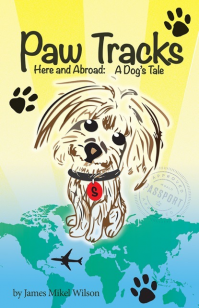 Paw Tracks Here and Abroad: A Dog's Tale
Genre: Humor, Teen & Young Adult, Children's, Advice & How To, Biographies & Memoirs
Paw Tracks Here and Abroad: A Dog's Tale
Genre: Humor, Teen & Young Adult, Children's, Advice & How To, Biographies & Memoirs
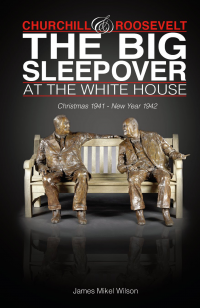 Churchill and Roosevelt: The Big Sleepover at the White House: Christmas 1941-New Year 1942
Genre: Historical Fiction, Visionary Fiction
Churchill and Roosevelt: The Big Sleepover at the White House: Christmas 1941-New Year 1942
Genre: Historical Fiction, Visionary Fiction

